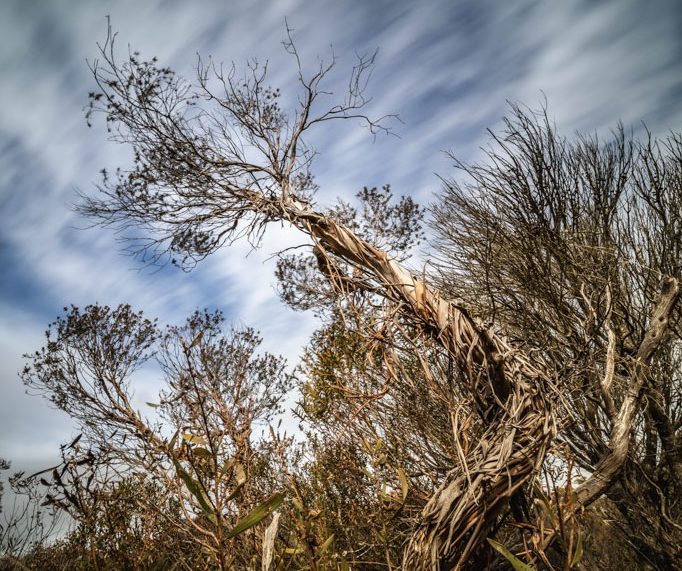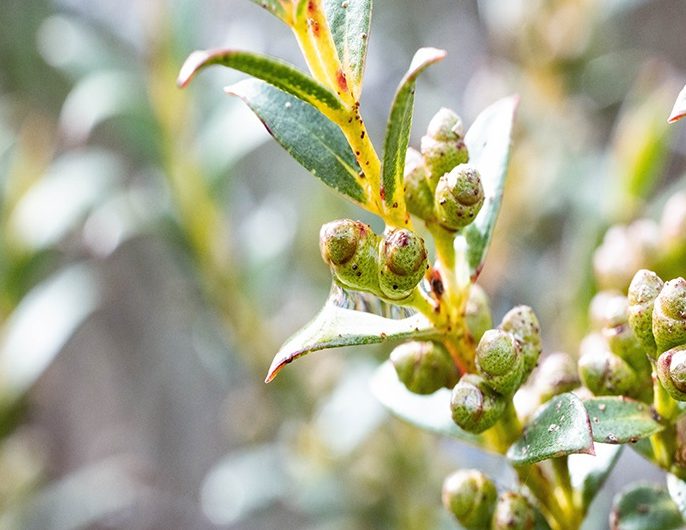
Only six Mongarlowe mallee plants exist. Photo: NSW Department of Planning and Environment.
Four top-secret locations in the NSW Southern Tablelands are home to Australia’s rarest tree species.
And, with only six individuals in existence, the mysterious Mongarlowe mallee may be Australia’s loneliest tree.
First discovered by a Braidwood landholder in 1985, the mysterious eucalypt, also known as the ice age gum, is estimated to be anywhere from 3,000 to 13,000 years old and is the nation’s rarest tree.
A second plant was discovered in the Mongarlowe area in 1990 by a botanical consultant undertaking a vegetation survey in relation to the then proposed Welcome Reef Dam, while a third plant was located north of Mongarlowe during a targeted aerial survey.
The critically endangered plants survive on privately-owned land in four secret locations on the Southern Tablelands, three near Mongarlowe and one near Windellama. Three of these sites each support only single plant, while the other site has three individuals.
Department of Planning and Environment (DPE) scientists are working with the Australian National Botanic Gardens in an effort to hand pollinate the plants to produce viable seeds and eventually grow ex-situ stock.
The Mongarlowe mallee grows to 4.2 metres tall and has distinctive small, opposite, outwardly curved leaves.
DPE Senior Ecologist Gen Wright said a closer look at the Mongarlowe mallee only posed more questions.
“This is a unique eucalypt, and its survival in the wild is dependant on the last known adult plants – of which there are only six,” Gen said.
“We think these trees are very old, and could be relics of past climates where they may have been more widespread.”
Gen sayid the flowering and seed production of the tree was very strange.
“Production of viable seed is difficult because the distance between all of the known trees is further than any self-respecting pollinator would want to travel,” she said.
This means the only pollen available to all Mongarlowe mallee trees is from its own flowers, which won’t produce viable seed, or from other eucalypt species that are flowering nearby at the same time.

Attempts are being made to hand pollinate the rare Mongarlowe mallee. Photo: NSW Department of Planning and Environment.
Seed produced with the pollen from these nearby trees result in hybrids, which is a eucalypt that is a genetic mix of two species and does not produce a true Mongarlowe mallee tree.
The only way to fix this problem is hand pollination, and in 2001/2002 the first viable seed was produced using this method. Back then all the Mongarlowe mallee trees were flowering at the same time, but by 2020 they had fallen out of sync.
“Each plant is now flowering at a slightly different time with just a short period of overlap, making repeating this hand cross-pollination extremely challenging,” Gen said.
“To complicate things even more, some of the plants are just not flowering at all!”
Conservation groups are focussing on the long-term protection of these special trees and their habitat, as they’re probably going to live for at least a few more hundred years.
Gen said all trees occur on private land, so maintaining a positive connection with landholders was incredibly important, as they are the true custodians of the plants.
Their location is kept top secret, because a major threat to this botanical curiosity is increased visitation and specimen collection from overly enthusiastic members of the public.
It’s hoped future hand pollination will produce viable seed. The Australian National Botanic Gardens in Canberra is ready to grow any seed, and is also trialling propagation techniques for the species using special grafting techniques.
Gen said this could all lead to an ex-situ population of the plant and it could one day become a garden plant like the Wollomi Pine.
“We have so much to learn about this plant … how long does it take to grow and how old are they? Are they the oldest eucalypts in Australia? Will we ever find another one?” she said.
A National Recovery Plan for the Mongarlowe mallee considers the conservation requirements of the species across its known range and identifies the actions to be taken to ensure its long-term viability in nature, including site protection, complete genetic studies and the possible lowering of the maximum water level of the dam at Windellama.
Original Article published by Katrina Condie on About Regional.












